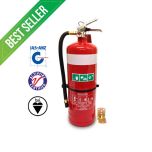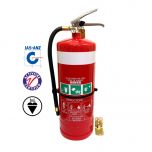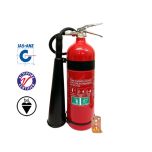A fire extinguisher is a first attack style fire protection device used to extinguish or control smaller fires. Due to the proximity one must get to a fire for a portable extinguisher to be effective, it is not designed to fight or control large or out of control fires as this can endanger the user. In larger fires the portable extinguisher may be used to create or clear an escape route in the event a fire traps an occupant.
The modern day portable fire extinguisher consists of steel or alloy hand held cylindrical pressurised canister and contains various contents or suppressant agents in the forms of powders, liquids or gasses, which are propelled or discharged out to extinguish fires.
To create or ignite a fire you have to have the three necessary ingredients that are commonly known to make up the “Fire Triangle”:
1. Fuel - You need some sort of combustible solid, liquid or gas
2. Oxygen (or oxidizing agent) - to react with the fuel
3. Heat - There must be enough heat to get the fuel above its flash point.
So if you want to put out a fire, you need to remove one of the three elements and so break the triangle.
Though all portable fire extinguishers do have the primary function of putting out a fire, they are not all the same and they do not all put out a fire in the same way. By knowing which types of fire extinguishers to use for a certain type of fire, you can avoid doing further damages to your property and most important of all, to yourself.
Dry Chemical Powder (DCP) – Red Cylinder with a White Band
Dry chemical powder or commonly called (ABE) fire extinguishers are by far the most common fire extinguishers in the home and workplace due to the large range of fires they can fight as well as their relatively low cost to purchase. They can handle all three types of fires you would find in a kitchen or workshop: designed to extinguish Class A, B and E fires (combustible solids like wood or paper, combustible liquids like gasoline or grease, and electrical fires). The idea behind a dry chemical fire extinguisher is to blanket the fuel with an inert solid (similar to dirt or sand).
Using a Nitrogen propellant, dry chemical extinguisher sprays a very fine powder of sodium bicarbonate (baking soda), potassium bicarbonate (nearly identical to baking soda), or mono-ammonium phosphate, these solids coat the fuel and smother the fire.
Carbon Dioxide (CO2) – Red Cylinder with a Black Band
A carbon-dioxide fire extinguisher works by eliminating oxygen and replacing it with in this case carbon dioxide. You could do the same thing with just about any non-oxidizing gas (nitrogen, for example), but carbon dioxide is inexpensive and easy to store.
Carbon Dioxide Fire Extinguishers are designed to extinguish Class E electrical hazard fires, as well as small or limited Class B flammable liquid fires and Class A combustible fires (e.g. wood and paper).
What’s more, because carbon dioxide is a non-conductive and non-corrosive gas, these extinguishers won’t damage surrounding equipment such as computers and servers.
Water, Foam & Wet Chemical Extinguishers (Liquid Extinguishers)
Water Fire Extinguishers – Red Cylinder with no Coloured Band
Water filled fire extinguishers work by reducing heat, cooling the temperature below ignition point. Water extinguishers may contain other chemicals or additives such as freezing point depressants or wetting agents to help prevent corrosion in the cylinder.
Primarily used for Class A – paper, textiles, wood, most plastics and rubber fires in smaller buildings and areas not serviced by fire hose reels.
Foam Fire Extinguishers – Red Cylinder with a Blue Coloured Band
Foam extinguishers are commonly found in car parks and petrol stations and used on Class B – flammable liquids fires like petroleum fires (plus small Class A fires),
Aqueous Film-Forming Foam (AFFF) is mixed with water and used in common flammable liquid fires such as petrol, paint or oil.
A foam fire extinguisher puts out fires by covering the flames with a thick blanket of foam, excluding oxygen and undermining its capacity to release flammable vapours.
While in Class A fires it also lowers their temperature.
Wet Chemical Fire Extinguishers– Red Cylinder with a Oatmeal Coloured Band
Class F – cooking oils or fats (plus small Class A fires), the extinguishing agent reacts with the surface of the cooking oil or fats to create a barrier or seal which starves oxygen supply.
Wet Chemical Fire Extinguishers are most commonly found in kitchens where deep frying is required.




